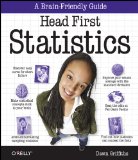I have come to believe that statistics is one of those important subjects that most of us know woefully little about even as we increasingly rely on the results of various studies to drive our lifestyle choices or on data visualisation to take decisions at our workplace. That said, I have been procrastinating on my resolution to study this subject in greater depth than what was afforded by an introductory course I took in college ages ago. The first step towards that goal has now been precipitated due to the nature of my current work. Unfortunately for me, most of the books on this subject looked too dull or intimidating to serve as a useful review of the basic concepts. “Head First Statistics” by Dawn Griffiths presented a welcome contrast with its pages full of informal text and fun pictures, though I was sceptical at first of its utility. I am happy to report that my scepticism was entirely misplaced.
The book is another in the series of “Head First” books by O'Reilly. True to its pedigree, this book uses lots of little stories, pictures and exercises to provide a gentle introduction to otherwise complicated-looking topics. Each chapter asks you to help denizens of the fictional town of “Statsville” with their sundry problems using increasingly-complicated statistical techniques. Unlike most text-books where the exercises are lumped together at the end of each chapter or section, sometimes without solutions or hints, this book makes the exercises an integral part of its flow and works out the solution for each of them in full after letting you take a crack at it first.
All the usual suspects of statistics are here: data visualisation, mean, median, mode, standard deviation, probabilities, probability distributions, normal curves, sampling, hypothesis tests, t-distribution, chi-square distribution, etc. I was frankly a bit surprised that the author managed to cover so much ground in a book like this. My kudos to her for making most of it so accessible to the lay reader.
Of course, despite her valiant efforts the author loses her grip on lucidity in the latter half of the book that covers advanced topics and where many a formula or statement is left hanging with an implicit “Just take my word for it”. This could be deeply dissatisfying if you are of an enquiring disposition. There are no references to books, papers, articles or web-sites where the reader can go to find more information or get a deeper understanding of the concepts. There should have been some practice problems for the reader to test their understanding, with the solutions perhaps available from a web-site. One of my major grudges was the sudden switch to probability from statistics in the early chapters without any explanation - only if you persist do you discover in the later chapters how closely the two are linked to each other and get your “Aha!” moment of understanding. Finally I really believe that the book could have been thinner given the ground that it covers.
While I feel that this is a great book to use to get introduced to this important subject, it is not suitable for use as a reference or as a guide to get a deeper understanding of the concepts. It will certainly whet your appetite for the subject and is a great book if you find yourself scared by the subject.
